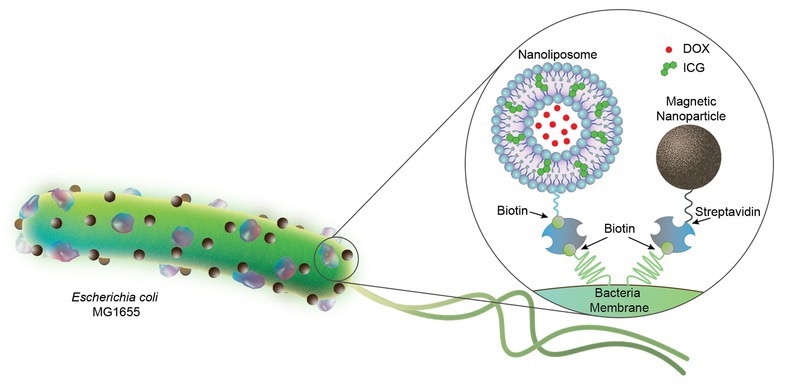By incorporating artificial components into E. coli bacteria to create biohybrid microrobots, a group of researchers from the Max Planck Institute for Intelligent Systems’ Physical Intelligence Department has integrated robotics with biology. The scientists first connected several nanoliposomes to each bacterium, as seen in the image below.
 Bacterial biohybrids carrying nanoliposomes (200 nm) and magnetic nanoparticles (100 nm). Nanoliposomes are loaded with chemotherapeutic DOX and photothermal agent ICG, and both cargoes are conjugated to E. coli bacteria (2 to 3 µm in length) via biotin-streptavidin interactions. Image Credit: Akolpoglu et al., Sci. Adv. 8, eabo6163 (2022).
Bacterial biohybrids carrying nanoliposomes (200 nm) and magnetic nanoparticles (100 nm). Nanoliposomes are loaded with chemotherapeutic DOX and photothermal agent ICG, and both cargoes are conjugated to E. coli bacteria (2 to 3 µm in length) via biotin-streptavidin interactions. Image Credit: Akolpoglu et al., Sci. Adv. 8, eabo6163 (2022).
These spherical carriers contain a substance (ICG, green particles) on their outer circle that melts when exposed to near-infrared light. The liposomes enclose water-soluble chemotherapeutic drug molecules (DOX) more toward the center, inside the aqueous core.
Magnetic nanoparticles are the second element the researchers added to the bacteria. Iron oxide particles act as an additional booster for this already very mobile microbe when it is subjected to a magnetic field. As a result, it is simpler to manage bacteria’s movement, which is a better design for an in vivo application.
The rope binding the liposomes and magnetic particles to the bacterium is a very stable and hard-to-break streptavidin and biotin complex, which was developed a few years prior and comes in useful when constructing biohybrid microrobots.
E. coli bacteria are adept swimmers that can move across a variety of media, including liquids and very viscous tissues. But that is not all; they also possess very advanced sensory skills. Bacteria are attracted to chemical gradients like high acidity or low oxygen levels, both of which are present close to tumor tissue. The term “bacteria-mediated tumor treatment” refers to the process of treating cancer by administering microorganisms nearby.
The patients’ immune systems are triggered as a result of the microorganisms moving to the tumor, growing there, and spreading. For more than a century, bacteria-mediated tumor therapy has been a kind of treatment.
Researchers have been attempting to boost this microorganism’s abilities for the last several decades. Scientists provided bacteria with more tools to aid in the struggle. However, intergrating artificial elements is not a simple operation. There are intricate chemical processes at work, and to prevent dilution, the density rate of particles placed onto the bacterium is important.
The Stuttgart group has now set a very high standard. They were successful in delivering liposomes and magnetic particles to 86 out of 100 bacteria.
The researchers demonstrated how they were able to drive such a high-density solution externally in various directions. First, via a small, L-shaped channel with two compartments on each end, each containing a tumor spheroid. Then, a setup that was much more restricted and resembled microscopic blood vessels. Scientists demonstrated how they accurately steer the drug-loaded microrobots toward tumor spheroids by adding an additional permanent magnet on one side.
Third, taking things a step further, the scientists guided the tiny robots through a thick collagen gel that had three different stiffness and porosity levels, ranging from soft to rigid (like tumor tissue). Bacteria have a harder time breaking through the matrix the stiffer the collagen and the tighter the protein string web, as seen in Figure.
The researchers demonstrated that once a magnetic field is added, the bacteria can traverse all the way to the other end of the gel due to their increased force. The bacteria penetrated the fibers due to constant alignment.
Once the microrobots have gathered at the targeted location (the tumor spheroid), a near-infrared laser produces beams with temperatures of up to 55 °C, which start the melting process of the liposome and cause the drugs within to release. The drugs are automatically released around a tumor as a result of the nanoliposomes breaking apart in an acidic or low pH environment.
Imagine we would inject such bacteria based microrobots into a cancer patient’s body. With a magnet, we could precisely steer the particles towards the tumor. Once enough microrobots surround the tumor, we point a laser at the tissue and by that trigger the drug release. Now, not only is the immune system triggered to wake up, but the additional drugs also help destroy the tumor.
Birgül Akolpoglu, Study First Author and PhD Student, Physical Intelligence Department, Max Planck Institute–Intelligent Systems
Dr. Yunus Alapan, a former postdoctoral researcher in the Physical Intelligence Department, and Akolpoglu co-led the paper. On July 15th, 2022, it was published in Science Advances. “This on-the-spot delivery would be minimally invasive for the patient, painless, bear minimal toxicity and the drugs would develop their effect where needed and not inside the entire body,” Alapan says.
Bacteria-based biohybrid microrobots with medical functionalities could one day battle cancer more effectively. It is a new therapeutic approach not too far away from how we treat cancer today. The therapeutic effects of medical microrobots in seeking and destroying tumor cells could be substantial. Our work is a great example of basic research that aims to benefit our society.
Dr. Metin Sitti, Study Last Author and Professor, Physical Intelligence Department, Max Planck Institute–Intelligent Systems
Journal Reference
Akolpoglu, M. B, et al. (2022) Magnetically steerable bacterial microrobots moving in 3D biological matrices for stimuli-responsive cargo delivery. Science Advances. doi.org/10.1126/sciadv.abo6163.